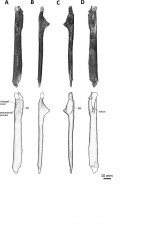Systematic paleontology
Order Aves Linnaeus, 1758
Family Plotopteridae Howard, 1969
Genus Copepteryx Olson and Hasegawa, 1996
Type species.—Copepteryx hexeris Olson and Hasegawa, 1996.
Material.—KMNH VP 600009, incomplete left coracoid, the extremitas omalis coracoidei portion is preserved.
Locality.—Kaijima Island, Kitakyushu, Fukuoka, Japan.
Horizon and age.—Yamaga Formation, Ashiya Group (late early Oligocene).
Emended diagnosis.—Olson and Hasegawa (1996) described the following characteristics as diagnostic features of Copepteryx hexeris: the scapular end of C. hexeris differs from that of Plotopterum and Tonsala in having an elongated glenoid facet with no distinct margin above the shaft, no sinuate sternal margin, ventral furcular facet, and relatively long and narrow coracohumeral surface (Olson, 1980).
In the present study, the following characters are added to the differential diagnosis (Table 1). A deeper longitudinal depression than most other protopterids is present on the dorsal surface at the facies articularis clavicularis. A well-developed ridge runs around the caudal side of the facies articularis clavicularis as a result of the deep depression of the recessus infra-acrocoracoideus. The position of the processsus lateralis is almost horizontal to the base (KMNH VP 200006 and fig. 1 in Olson and Hasegawa, 1996).
Stenornis gen. nov.
Type species.—Stenornis kanmonensis sp. nov.
Diagnosis.—As for the type and only species; the size is almost the same as Copepteryx hexeris.
Etymology.—The genus name “steno (στενό)” means strait in Greek, “ornis” means bird in Greek. The plotopterid fossil localities; Ainoshima, Kaijima, and Hikoshima islands are located at the Kanmon Strait.
Stenornis kanmonensis sp. nov.
Holotype.—Almost complete left coracoid (KMNH VP 200003).
Synonymy.—Tonsala? sp., Olson and Hasegawa (1996).
Locality.—Hikoshima Island, Shimonoseki, Yamaguchi, Japan.
Horizon and age.—Jinnobaru Formation, Ashiya Group (late early Oligocene).
Differential diagnosis.—The large-sized plotopterid differs from other plotopterids in the following characteristics. The angle between the processus acrocoracoideus and the shaft is about 95 to 100°. A craniocaudally elongated sulcus is situated on the ventral surface of the shaft. The facies articularis humeralis
has the following combination characters: situating closer to the dorsal side and a slight depression on the middle. The weakly convex processus lateralis is positioned more toward the cranial portion of the shaft (upward by about 50°). The tip of the processus lateralis is gently peaked and faces laterally. In addition, the facies articularis clavicularis broader and more bean-shaped than in other plotopterids.
Etymology.—The specific epithet is from the fossil locality located at the Kanmon Strait.
Paratype.—Right coracoid (KMNH VP 600010: lacking processus lateralis; Ainoshima Island, Kitakyushu, Fukuoka, Japan; Ashiya Group (Oligocene); collected by Masahiro Sato.
Empeirodytes gen. nov.
Type species.—Empeirodytes okazakii sp. nov.
Diagnosis.—As for the type and only species.
Etymology.—The genus name “empeiros (Έμπειρος)” means proficient in Greek, and “dytes (δύτης)” means diver in Greek.
Empeirodytes okazakii sp. nov.
Holotype.—Left coracoid lacking both sides of extremitas omalis coracoidei and extremitas sternalis coracoidei (KMNH VP 600011).
Locality.—Hiroiwa, Ainoshima Island, Kitakyushu, Fukuoka, Japan.
Horizon and age.—Ashiya Group (Oligocene).
Differential diagnosis.—Overall size is smaller than Copepteryx, Hokkaidornis, and Klallamornis and larger than Plotopterum and Stemec. The new species has the following two characteristics as the differential diagnosis. A depression develops on the ventral surface of the facies articularis humeralis portion of the shaft. This depression is deeper and more prominent than in Stenornis. A sharply defined ridge runs along the caudal margin of the labrum internum. In addition, the base of the procoracoid process is thick and trapezoidal. The dorsoventral depth of the overall shaft is very thin.
Etymology.—The specific epithet is in honor of Yoshihiko Okazaki who has studied vertebrate fossils,
including plotopterid birds from the Ashiya Group, Kitakyushu, Japan.
Paratype.—Right coracoid (KMNH VP 600012 lacking both sides of extremitas omalis coracoidei and extremitas sternalis coracoidei; Kaijima Island, Kitakyushu, Fukuoka, Japan; Ashiya Group (Oligocene).
Fred
Figure 1. Left coracoid of Copepteryx hexeris (KMNH VP 600009). Above; photos and below; drawings. A, dorsal view; B, medial view; C, lateral view; D, ventral view. Abbreviations: fac, facies articularis clavicularis; fah, facies articularis humeralis; fas, facies articularis scapularis.
Figure 2. Holotype of Stenornis kanmonensis gen. et sp. nov., left coracoid (KMNH VP 200003). Above; photos and below; drawings. A, dorsal view; B, medial view; C, lateral view; D, ventral view. Abbreviations: fac, facies articularis clavicularis; fah, facies articularis humeralis; fas, facies articularis scapularis; labr. ext. cor., labrum externum coracoidei; labr. int. cor., labrum internum coracoidei.
Figure 3. Holotype and paratype of Stenornis kanmonensis gen. et sp. nov. Left; holotype (KMNH VP 200003) and right; paratype (KMNH VP 600010) in each photo. A, dorsal view; B, medial view; C, lateral view; D, ventral view; E, proximal view; F, distal view.
Figure 4. Holotype of Empeirodytes okazakii gen. et sp. nov., left coracoid (KMNH VP 600011). Above; photos and below; drawings. A, dorsal view; B, medial view; C, lateral view; D, ventral view; E, distal view. Abbreviations: fas, facies articularis scapularis; labr. ext. cor., labrum externum coracoidei; labr. int. cor., labrum internum coracoidei.
Figure 5. Paratype of Empeirodytes okazakii gen. et sp. nov., right coracoid (KMNH VP 600012). Above; photos and below; drawings. A, dorsal view; B, medial view; C, lateral view; D, ventral view. Abbreviations: fah, facies articularis humeralis; fas, facies articularis scapularis.









